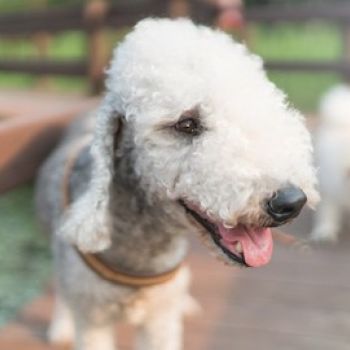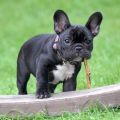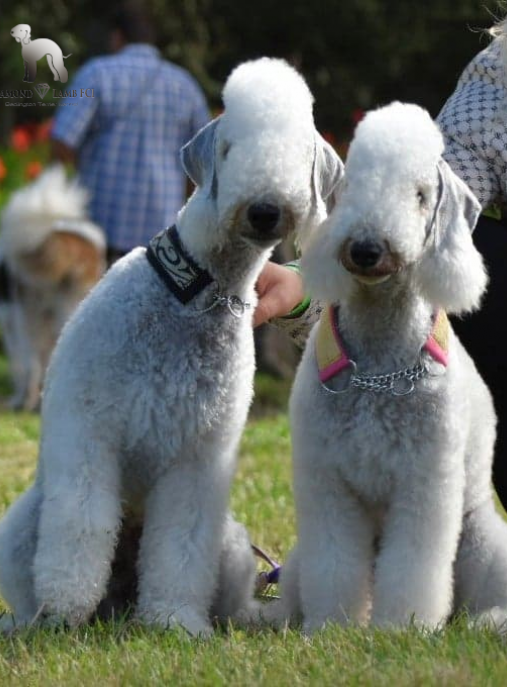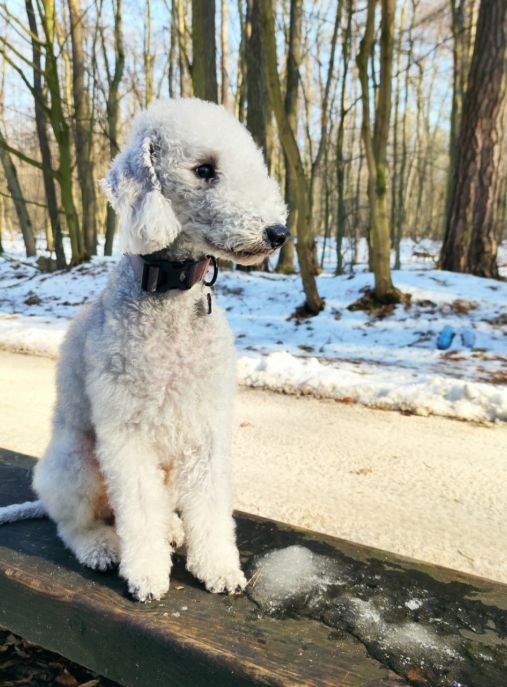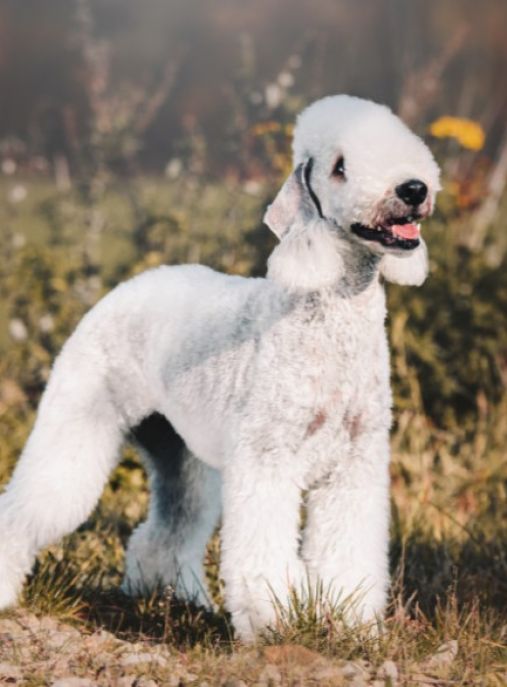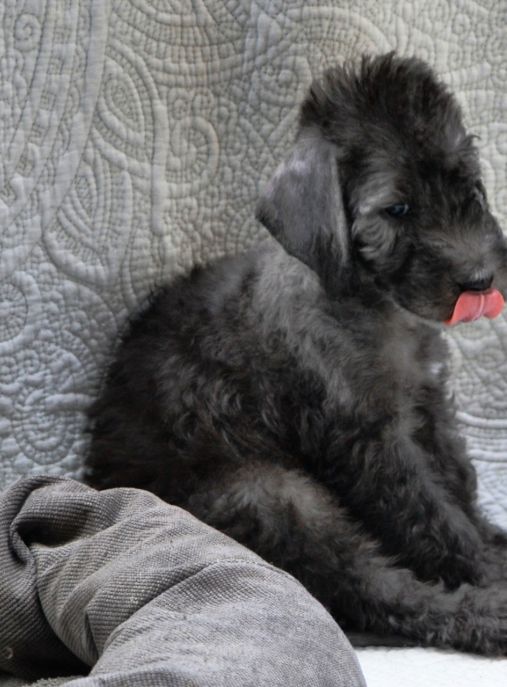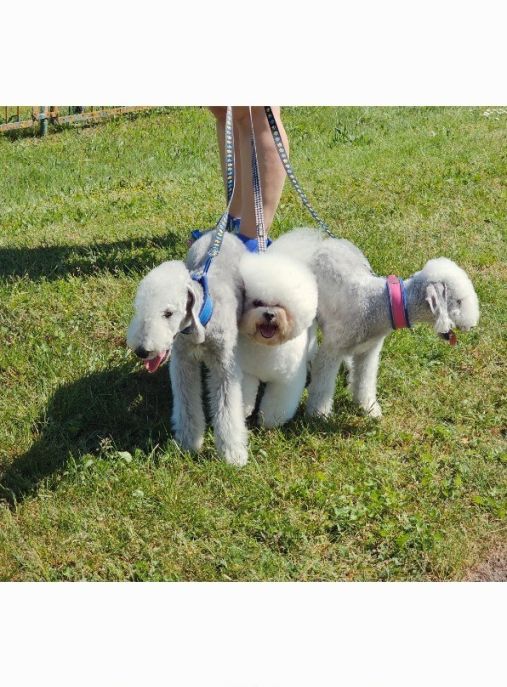The Bedlington Terrier is a small to medium-sized breed of dog that is known for its unique appearance and charming personality. With its distinctive lamb-like appearance, the Bedlington Terrier is often referred to as the "gentleman of the terrier world." This breed is highly regarded for its intelligence, loyalty, and versatility, making it a popular choice for both families and individuals alike.
Originating in the mining town of Bedlington in Northumberland, England, the Bedlington Terrier has a rich history that dates back to the 18th century. It is believed that the breed was developed by crossing various terrier breeds, including the Dandie Dinmont Terrier, Whippet, and Otterhound. The result was a dog that possessed the speed, agility, and hunting instincts of a terrier, combined with the grace and elegance of a sighthound.
According to the FCI (Fédération Cynologique Internationale) typology, the Bedlington Terrier belongs to Group 3 - Terriers. This group includes various terrier breeds that were originally bred for hunting and vermin control. The Bedlington Terrier is classified under Section 1 - Large and Medium-sized Terriers.
Bedlington Terriers are known for their versatility and adaptability. They excel in various activities such as obedience, agility, and even as therapy dogs. Their intelligence and eagerness to please make them highly trainable, although they may exhibit a stubborn streak at times. This breed thrives on human companionship and makes an excellent family pet, as they are known to be gentle and patient with children.
In terms of physical characteristics, the Bedlington Terrier is a medium-sized dog with a distinctive appearance. They have a long, narrow head with a slight stop, and their eyes are small and almond-shaped. The breed is known for its unique coat, which is a combination of soft, dense, and curly hair. The coat can come in various colors, including blue, liver, sandy, or a combination of these colors.
On average, a fully grown Bedlington Terrier stands at about 16 to 17.5 inches (40 to 44 cm) at the shoulder and weighs between 17 to 23 pounds (8 to 10.5 kg). Despite their small size, Bedlington Terriers are known for their athleticism and endurance. They have a well-muscled body and a graceful gait, which allows them to excel in various dog sports and activities.
The life expectancy of a Bedlington Terrier is typically around 12 to 16 years, although with proper care and nutrition, some individuals have been known to live even longer. This breed is generally healthy, but like all dogs, they may be prone to certain health conditions. Some of the common health issues that can affect Bedlington Terriers include copper toxicosis, kidney disease, and various eye problems.
One interesting fact about the Bedlington Terrier is that despite its elegant appearance, it is a formidable hunter. Originally bred to hunt vermin, this breed has a strong prey drive and may chase small animals if not properly trained and socialized. Additionally, Bedlington Terriers are known for their ability to swim, making them excellent companions for outdoor activities near water.
In conclusion, the Bedlington Terrier is a unique and versatile breed that combines the qualities of a terrier and a sighthound. With its distinctive appearance, intelligence, and gentle nature, this breed has won the hearts of many dog lovers around the world. Whether as a family pet or a working dog, the Bedlington Terrier continues to bring joy and companionship to those who have the pleasure of owning one.

The Bedlington Terrier is a unique and charming breed known for its distinctive appearance and delightful personality. With their lamb-like appearance and gentle nature, these dogs have won the hearts of many dog enthusiasts around the world. In this text, we will explore the character of Bedlington Terriers, their behavior, and how to raise and train them.
Bedlington Terriers are often described as intelligent, affectionate, and loyal companions. They have a calm and gentle demeanor, making them excellent family pets. These dogs thrive on human companionship and are known for their ability to form strong bonds with their owners. Bedlington Terriers are often referred to as "gentleman terriers" due to their refined manners and polite behavior.
One of the most distinctive features of Bedlington Terriers is their playful and mischievous nature. They have a zest for life and love engaging in various activities. These dogs are known for their agility and enjoy participating in dog sports such as agility, obedience, and even lure coursing. Their high energy levels make them excellent exercise partners, and they require regular physical and mental stimulation to stay happy and healthy.
When it comes to raising and training a Bedlington Terrier, it is important to establish a consistent and positive training routine from an early age. These dogs are highly intelligent and eager to please, making them relatively easy to train. However, they can also be independent thinkers, so patience and positive reinforcement are key.
Socialization is crucial for Bedlington Terriers to ensure they grow up to be well-rounded and friendly dogs. Exposing them to various people, animals, and environments from a young age will help them develop good social skills and prevent any potential behavioral issues. Early socialization also helps them become more accepting of new experiences and reduces the likelihood of fear or aggression towards unfamiliar situations.
Bedlington Terriers are generally good with children and other pets when properly socialized. However, as with any dog, supervision is necessary, especially when introducing them to new situations or individuals. Their gentle nature and playful disposition make them great companions for families with children.
Grooming is another important aspect of caring for a Bedlington Terrier. Their unique coat requires regular maintenance to keep it looking its best. The coat is a combination of soft and dense hair, which can easily become tangled or matted if not properly cared for. Regular brushing, bathing, and occasional professional grooming are necessary to keep their coat healthy and free of tangles.
In conclusion, Bedlington Terriers are intelligent, affectionate, and playful dogs that make wonderful family pets. Their gentle nature, combined with their mischievous personality, creates a unique and endearing character. With proper training, socialization, and grooming, Bedlington Terriers can thrive in various environments and bring joy to their owners' lives.
The Bedlington Terrier is a unique and charming breed known for its distinctive lamb-like appearance and friendly nature. To ensure the health and happiness of your Bedlington Terrier, it is important to provide them with proper care and attention. Here are some tips on how to care for dogs of this breed, including what to do and what not to do:
1. Grooming: Bedlington Terriers have a unique coat that requires regular grooming. Their curly, wool-like hair should be brushed at least once a week to prevent matting and tangling. Regular trimming is also necessary to maintain their signature look. It is recommended to take your Bedlington Terrier to a professional groomer every 6-8 weeks for a trim and to keep their coat in good condition.
2. Exercise: Despite their elegant appearance, Bedlington Terriers are active dogs that require regular exercise. Daily walks, playtime, and mental stimulation are essential to keep them physically and mentally fit. Engage them in activities like fetch, agility training, or obedience classes to keep them entertained and prevent boredom.
3. Socialization: Bedlington Terriers are generally friendly and sociable dogs, but early socialization is crucial to ensure they grow up to be well-rounded pets. Introduce them to various people, animals, and environments from a young age to help them develop good social skills and prevent any potential behavioral issues.
4. Training: Bedlington Terriers are intelligent and eager to please, making them relatively easy to train. Use positive reinforcement techniques such as treats, praise, and rewards to motivate them. Consistency, patience, and firmness are key when training this breed. Enroll them in obedience classes to enhance their training and socialization skills.
5. Health care: Regular veterinary check-ups are essential to monitor the overall health of your Bedlington Terrier. Vaccinations, parasite prevention, and dental care should be maintained as per your veterinarian's recommendations. Bedlington Terriers are prone to certain health issues such as copper toxicosis, kidney disease, and eye problems, so it is crucial to be aware of these conditions and seek appropriate medical attention if needed.
6. Nutrition: Provide your Bedlington Terrier with a balanced and nutritious diet to support their overall health. High-quality dog food, preferably formulated for small to medium-sized breeds, is recommended. Avoid overfeeding and monitor their weight to prevent obesity, which can lead to various health problems.
7. Safety: Bedlington Terriers have a curious nature, so it is important to ensure their safety. Secure your yard with a fence to prevent them from wandering off. Keep harmful substances, toxic plants, and small objects out of their reach. Supervise them around water bodies as they may have a natural inclination to swim.
What not to do:
1. Do not neglect grooming: Neglecting regular grooming can lead to matting, skin issues, and discomfort for your Bedlington Terrier. Regular brushing and professional grooming are essential to maintain their coat's health and appearance.
2. Do not skip exercise: Bedlington Terriers are active dogs that require regular exercise. Lack of physical activity can lead to obesity, boredom, and behavioral problems. Make sure to provide them with daily exercise and mental stimulation.
3. Do not use harsh training methods: Bedlington Terriers respond best to positive reinforcement training methods. Avoid using harsh or punitive techniques as it can lead to fear or aggression. Instead, focus on rewards, praise, and consistency to achieve desired results.
4. Do not ignore health issues: Bedlington Terriers are prone to certain health conditions, so it is important to be vigilant and seek veterinary care if you notice any signs of illness or discomfort. Regular check-ups and preventive care are crucial to ensure their well-being.
By following these tips and providing your Bedlington Terrier with love, care, and attention, you can ensure they lead a happy and fulfilling life as a cherished member of your family.
The Bedlington Terrier is a unique and charming breed known for its distinctive appearance, and one of the defining features of this breed is its common color. Bedlington Terriers typically have a coat that is predominantly a soft and lustrous shade of blue. This beautiful hue is often described as a pale, silvery blue or a bluish-gray color.
The blue color of the Bedlington Terrier's coat is a result of a combination of genetics and pigmentation. The breed's coat is made up of individual hairs that have a unique structure, which contributes to the soft and woolly texture. These hairs contain a combination of black and white pigments, which, when combined, create the overall blue appearance.
The blue color of the Bedlington Terrier's coat can vary in intensity and shade. Some dogs may have a lighter, almost silver-like blue coat, while others may have a deeper, more saturated blue color. The shade of blue can also be influenced by factors such as lighting conditions and the individual dog's genetics.
In addition to the blue coat, Bedlington Terriers often have other color variations present on their bodies. These variations are usually found on the head, ears, and tail. The most common color variations seen in Bedlington Terriers include liver, sandy, and tan. These colors can appear as patches or markings on the blue coat, adding to the breed's unique and eye-catching appearance.
The blue coat of the Bedlington Terrier requires regular grooming and maintenance to keep it looking its best. The soft and woolly texture of the coat can easily become tangled and matted if not properly cared for. Regular brushing and occasional trimming are necessary to prevent matting and maintain the coat's beautiful blue color.
The blue coat of the Bedlington Terrier not only adds to its aesthetic appeal but also serves a functional purpose. The dense and wiry texture of the coat provides protection against harsh weather conditions and helps to insulate the dog's body. This makes the breed well-suited for various climates and outdoor activities.
In conclusion, the common color of Bedlington Terrier dogs is a soft and lustrous shade of blue. This unique and eye-catching coat color, combined with the breed's distinctive appearance, makes the Bedlington Terrier a truly remarkable and beautiful breed.
The Bedlington Terrier is a unique and charming breed known for its distinctive lamb-like appearance and gentle nature. While generally a healthy breed, like any other, they are prone to certain health issues that owners should be aware of. In this text, we will explore the most common diseases found in Bedlington Terriers and provide tips on how to care for their overall health.
One of the most prevalent health concerns in Bedlington Terriers is copper toxicosis. This genetic disorder causes an abnormal accumulation of copper in the liver, leading to liver damage and potential failure. Symptoms may include lethargy, loss of appetite, jaundice, and increased thirst and urination. Regular monitoring of liver function through blood tests is crucial, and a low-copper diet is often recommended to manage this condition.
Another common health issue in Bedlington Terriers is hereditary nephritis, also known as copper-associated renal disease. This condition affects the kidneys and can lead to kidney failure. Symptoms may include increased thirst, frequent urination, weight loss, and lethargy. Regular check-ups with a veterinarian, along with urine and blood tests, can help detect and manage this condition.
Patellar luxation is another concern in Bedlington Terriers. This condition occurs when the kneecap slips out of its normal position, causing discomfort and lameness. Mild cases can be managed with weight control and exercise moderation, while severe cases may require surgical intervention.
Like many other breeds, Bedlington Terriers are also prone to certain eye conditions. Progressive retinal atrophy (PRA) is a degenerative disease that leads to gradual vision loss and eventual blindness. Regular eye examinations by a veterinary ophthalmologist can help detect PRA early on. Additionally, cataracts and distichiasis (abnormal eyelash growth) are also seen in this breed.
To ensure the overall health and well-being of your Bedlington Terrier, it is essential to provide them with proper care. Regular exercise is crucial to maintain their physical and mental health. Daily walks, playtime, and mental stimulation through interactive toys or training sessions are recommended.
A balanced and nutritious diet is vital for the health of Bedlington Terriers. High-quality dog food, preferably formulated for their specific needs, should be provided. Avoid overfeeding and monitor their weight to prevent obesity, as excess weight can exacerbate certain health conditions.
Regular veterinary check-ups are essential to catch any potential health issues early on. Routine vaccinations, parasite prevention, and dental care should not be overlooked. Bedlington Terriers are prone to dental problems, so regular teeth brushing and professional dental cleanings are crucial.
Grooming is another important aspect of caring for a Bedlington Terrier's health. Their unique coat requires regular maintenance, including regular brushing, trimming, and occasional professional grooming. Regular ear cleaning is also necessary to prevent ear infections, which can be common in this breed.
In conclusion, while Bedlington Terriers are generally healthy dogs, they are prone to certain genetic conditions that require careful monitoring and management. Regular veterinary care, a balanced diet, exercise, and proper grooming are essential for their overall health and well-being. By providing them with the care they need, you can ensure that your Bedlington Terrier leads a happy and healthy life.
The Bedlington Terrier is a unique and charming breed known for its distinctive appearance and playful personality. When it comes to their nutrition, providing a well-balanced diet is crucial to ensure their overall health and well-being. In this text, we will delve into the nutritional needs of Bedlington Terriers, offering advice on what and how to feed them, as well as highlighting foods to avoid.
Bedlington Terriers require a diet that is rich in high-quality protein, healthy fats, and essential vitamins and minerals. Protein is essential for muscle development and repair, and it should make up a significant portion of their diet. Look for dog foods that list a high-quality source of animal protein, such as chicken, turkey, or fish, as the first ingredient.
To maintain their energy levels, Bedlington Terriers also need a moderate amount of healthy fats. These fats can be derived from sources like fish oil, flaxseed oil, or chicken fat. Additionally, fats aid in the absorption of fat-soluble vitamins, which are essential for their overall health.
Carbohydrates are another important component of a Bedlington Terrier's diet. However, it is crucial to choose complex carbohydrates that provide sustained energy rather than simple sugars. Look for dog foods that contain whole grains like brown rice, oats, or quinoa. These grains are rich in fiber, which aids in digestion and helps regulate blood sugar levels.
When it comes to feeding Bedlington Terriers, it is recommended to divide their daily food intake into two or three smaller meals. This helps prevent bloating and aids in digestion. The exact amount of food will depend on factors such as age, weight, activity level, and metabolism. Consult with your veterinarian to determine the appropriate portion sizes for your specific dog.
In addition to commercial dog food, Bedlington Terriers can benefit from the inclusion of fresh, whole foods in their diet. Lean meats like chicken or turkey, along with cooked vegetables such as carrots, peas, and sweet potatoes, can be added as occasional treats or mixed with their regular food. However, it is important to avoid seasoning or adding any harmful ingredients like onions, garlic, or excessive salt.
While some human foods can be safe for dogs, there are certain foods that should be strictly avoided. These include chocolate, caffeine, grapes, raisins, onions, garlic, avocados, and foods containing xylitol, as they can be toxic to dogs and potentially lead to serious health issues.
Proper hydration is also essential for Bedlington Terriers. Always ensure that fresh, clean water is readily available for your dog throughout the day. Regularly check their water bowl to ensure it is clean and refill it as needed.
Lastly, it is important to monitor your Bedlington Terrier's weight and adjust their food intake accordingly. Obesity can lead to various health problems, so it is crucial to maintain a healthy weight through portion control and regular exercise.
In conclusion, providing a well-balanced diet is vital for the health and happiness of Bedlington Terriers. Focus on high-quality protein, healthy fats, and complex carbohydrates, while avoiding harmful foods. Remember to consult with your veterinarian for personalized advice and to ensure your Bedlington Terrier's nutritional needs are met.


